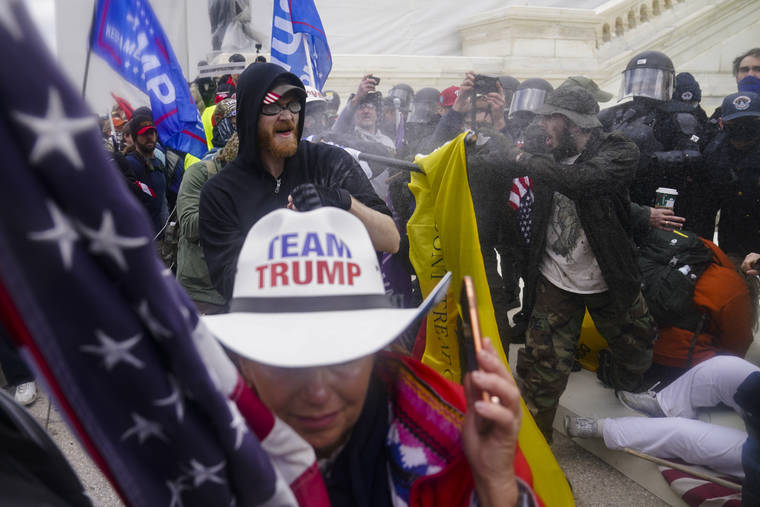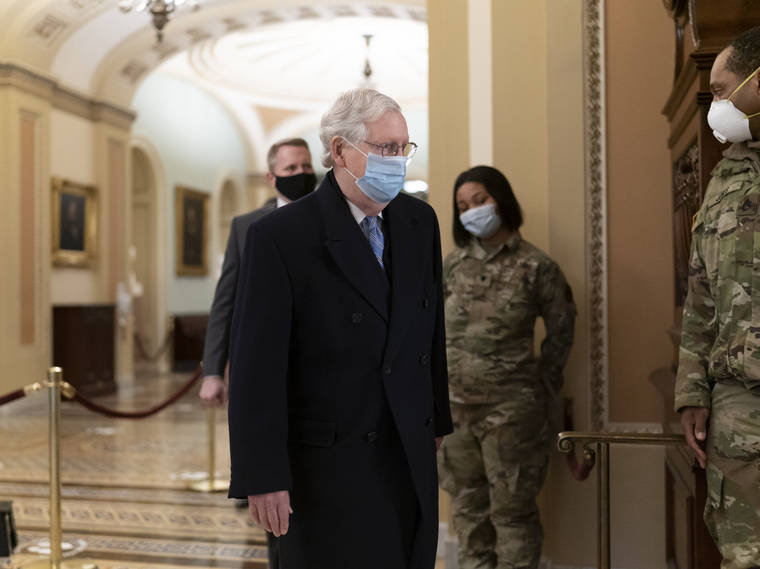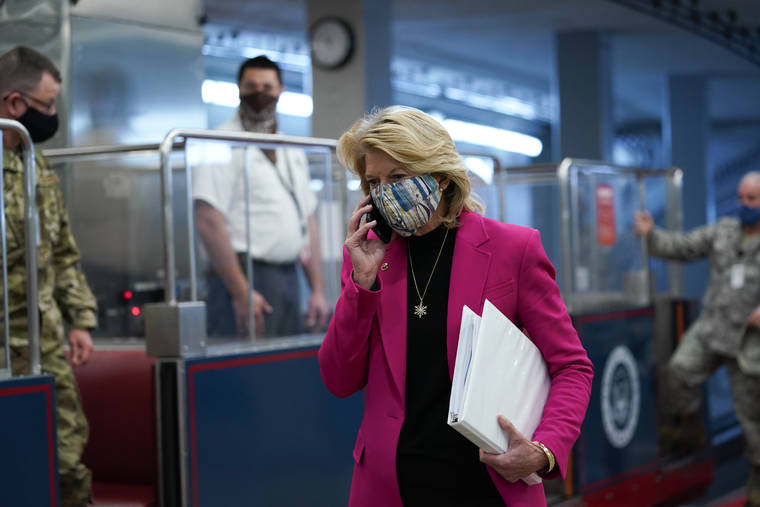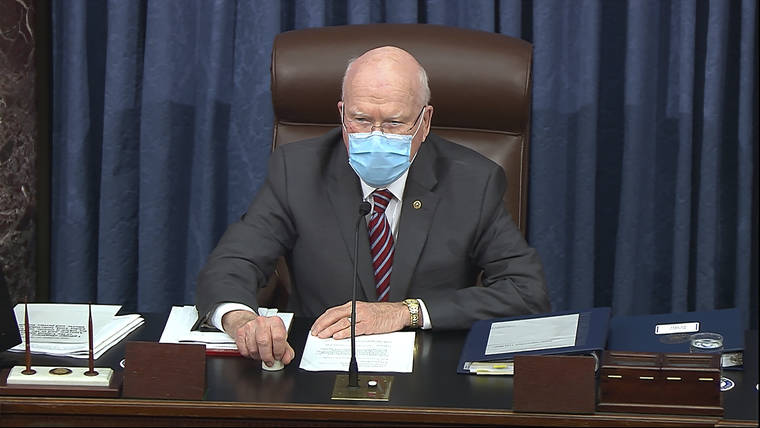Trump’s historic 2nd trial opens with jarring video of siege

FILE - In this Jan. 6, 2021, file photo rioters loyal to President Donald Trump try to break through a police barrier at the Capitol in Washington. Arguments begin Tuesday, Feb. 9, in the impeachment trial of Donald Trump on allegations that he incited the violent mob that stormed the U.S. Capitol on Jan. 6. (AP Photo/John Minchillo, File)

Senate Minority Leader Mitch McConnell, R-Ky., arrives for work as the second impeachment trial of former President Donald Trump begins in the Senate, at the Capitol in Washington, Tuesday, Feb. 9, 2021. (AP Photo/J. Scott Applewhite)

Sen. Susan Collins, R-Maine, and Sen. Mike Lee, R-Utah, arrive ahead of the second impeachment trial of former President Donald Trump in the Senate on Capitol Hill Tuesday, Feb. 9, 2021, in Washington. (AP Photo/Susan Walsh)

Members of the National Guard stand the Senate subway as Sen. Lisa Murkowski, R-Alaska, arrives ahead of the second impeachment trial of former President Donald Trump in the Senate on Capitol Hill Tuesday, Feb. 9, 2021, in Washington. (AP Photo/Susan Walsh)

In this image from video, Sen. Patrick Leahy, D-Vt., the president pro tempore of the Senate, who is presiding over the second impeachment trial of former President Donald Trump, opens the trial day in the Senate at the U.S. Capitol in Washington, Tuesday, Feb. 9, 2021. (Senate Television via AP)
WASHINGTON — Donald Trump’s historic second impeachment trial opened Tuesday in the Senate with graphic video of the deadly Jan. 6 attack on Congress and the defeated former president whipping up a rally crowd — “We’re going to walk down to the Capitol!” — as he encouraged a futile fight over his presidency.
WASHINGTON — Donald Trump’s historic second impeachment trial opened Tuesday in the Senate with graphic video of the deadly Jan. 6 attack on Congress and the defeated former president whipping up a rally crowd — “We’re going to walk down to the Capitol!” — as he encouraged a futile fight over his presidency.
The lead House prosecutor told senators the case would present “cold, hard facts” against Trump, who is charged with inciting the siege of the Capitol to overturn the election he lost to Democrat Joe Biden. Senators sitting as jurors, many who themselves fled for safety that day, watched the jarring video that showed the chaotic scene, rioters pushing past police to storm the halls, Trump flags waving.
“That’s a high crime and misdemeanor,” said Rep. Jamie Raskin, D-Md., in opening remarks. “If that’s not an impeachable offense, then there’s no such thing.”
Trump is the first president to face impeachment charges after leaving office and the first to be twice impeached . The Capitol siege stunned the world as rioters stormed the building to try to stop the certification of Biden’s victory, a domestic attack on the nation’s seat of government unlike any in its history. Five people died.
Trump’s lawyers are insisting that he is not guilty of the sole charge of “incitement of insurrection,” his fiery words just a figure of speech as he encouraged a rally crowd to “fight like hell” for his presidency. But prosecutors say he “has no good defense” and they promise new evidence.
“Hear ye, hear ye, hear ye,” the acting sergeant at arms intoned to start the trial.
Security remains extremely tight at the Capitol, a changed place after the attack, fenced off with razor wire and armed National Guard troops on patrol. The nine House managers walked across the shuttered building to prosecute the case before the Senate.
In an opening prayer, Senate Chaplain Barry Black asked God to “take control of this impeachment trial” and “have mercy on our beloved land.”
With senators gathered as the court of impeachment, sworn to deliver “impartial justice,” the trial is starting with debate and a vote over whether it’s constitutionally permissible to prosecute Trump after he is no longer in the White House. First, senators were voting on a resolution laying out the trial schedule for the day’s ahead.
Senate Majority Leader Chuck Schumer said it was the senators’ “solemn constitutional duty” to conduct a fair trial of “the gravest charges ever brought against a president.”
Presiding is not the Chief Justice of the Supreme Court, as has been tradition for the nation’s few presidential impeachment trials, but the chamber’s senior-most member of the majority party, Sen. Patrick Leahy of Vermont.
Acquittal is likely, but the trial will test the nation’s attitude toward his brand of presidential power, the Democrats’ resolve in pursuing him, and the loyalty of Trump’s Republican allies defending him.
“In trying to make sense of a second Trump trial, the public should keep in mind that Donald Trump was the first president ever to refuse to accept his defeat,” said Timothy Naftali, a clinical associate professor at New York University and an expert on impeachment.
“This trial is one way of having that difficult national conversation about the difference between dissent and insurrection,” Naftali said.
Trump’s defense team has embraced the question of constitutionality, which could resonate with Republicans eager to acquit Trump without being seen as condoning his behavior. They argue in filings the trial is “patently ridiculous.”
But the House prosecutors will cite the nation’s founders to declare a president “must answer comprehensively for his conduct in office from his first day in office through his last.” There is no “January exception” just before he leaves office, they will argue, according to aides granted anonymity to discuss the arguments ahead of the trial.
It appears unlikely that the House prosecutors will call witnesses, in part because the senators sworn as jurors, forced to flee for safety, will be presented with graphic videos recorded that day. At his Mar-a-Lago club in Florida, Trump has declined a request to testify.
Instead, House managers prosecuting the case will show videos of the violence, including never before seen evidence, and chart a succinct story beginning with Trump’s false claims the election was stolen and ending with the attempt at insurrection.
Trump’s defense team has said it plans to counter with its own cache of videos of Democratic politicians making fiery speeches. “We have some videos up our sleeve,” Senior Trump adviser Jason Miller said on a podcast Monday.
White House press secretary Jen Psaki said Monday that Biden will be busy with the business of the presidency and won’t spend much time watching the televised proceedings. “He’ll leave it to his former colleagues in the Senate,” she said.
A first test Tuesday will be on a vote on the constitutionality of the trial, signaling attitudes in the Senate. The chamber is divided 50-50 between Democrats and Republicans, with a two-thirds vote, 67 senators, required for conviction.
A similar question was posed late last month, when Sen. Rand Paul of Kentucky forced a vote to set aside the trial because Trump was no longer in office. At that time, 45 Republicans voted in favor of Paul’s measure. Just five Republicans joined with Democrats to pursue the trial: Mitt Romney of Utah, Ben Sasse of Nebraska, Susan Collins of Maine, Lisa Murkowski of Alaska and Pat Toomey of Pennsylvania
Presidential impeachment trials have been conducted only three times before, leading to acquittals for Andrew Johnson, Bill Clinton and then Trump last year.
Typically senators sit at their desks for such occasions, but the COVID-19 crisis has upended even this tradition. Instead, senators will be allowed to spread out, in the “marble room” just off the Senate floor, where proceedings will be shown on TV, and in the public galleries above the chamber, to accommodate social distancing, according to a person familiar with the discussions.
Under an agreement between Senate Majority Leader Chuck Schumer and Republican leader Mitch McConnell, the opening arguments would begin at noon Wednesday, with up to 16 hours per side for presentations.
After that there are hours for deliberations, witnesses and closing arguments. The trial is expected to continue into the weekend and next week.
In filings, lawyers for the former president lobbed a wide-ranging attack against the House case, dismissing the trial as “political theater” on the same Senate floor invaded by the mob.
Trump’s defenders suggest he was simply exercising his First Amendment rights when he encouraged his supporters to protest at the Capitol, and they argue the Senate is not entitled to try Trump now that he has left office.
House impeachment managers, in their own filings, assert that Trump “betrayed the American people” and has no valid excuse or defense.
“His incitement of insurrection against the United States government — which disrupted the peaceful transfer of power — is the most grievous constitutional crime ever committed by a president,” the Democrats have said.
Trump’s second impeachment trial is expected to diverge from the lengthy, complicated affair of a year ago. In that case, Trump was charged with having privately pressured Ukraine to dig up dirt on Biden, then a Democratic rival for the presidency.
This time, Trump’s “stop the steal” rally rhetoric and the storming of the Capitol played out for the world to see. The trial could be over in half the time.
The Democratic-led House impeached the president swiftly, one week after the most violent attack on Congress in more than 200 years. Five people died, including a woman shot by police inside the building and a police officer who died the next day of his injuries.
———
Associated Press writer Hope Yen contributed to this report.


